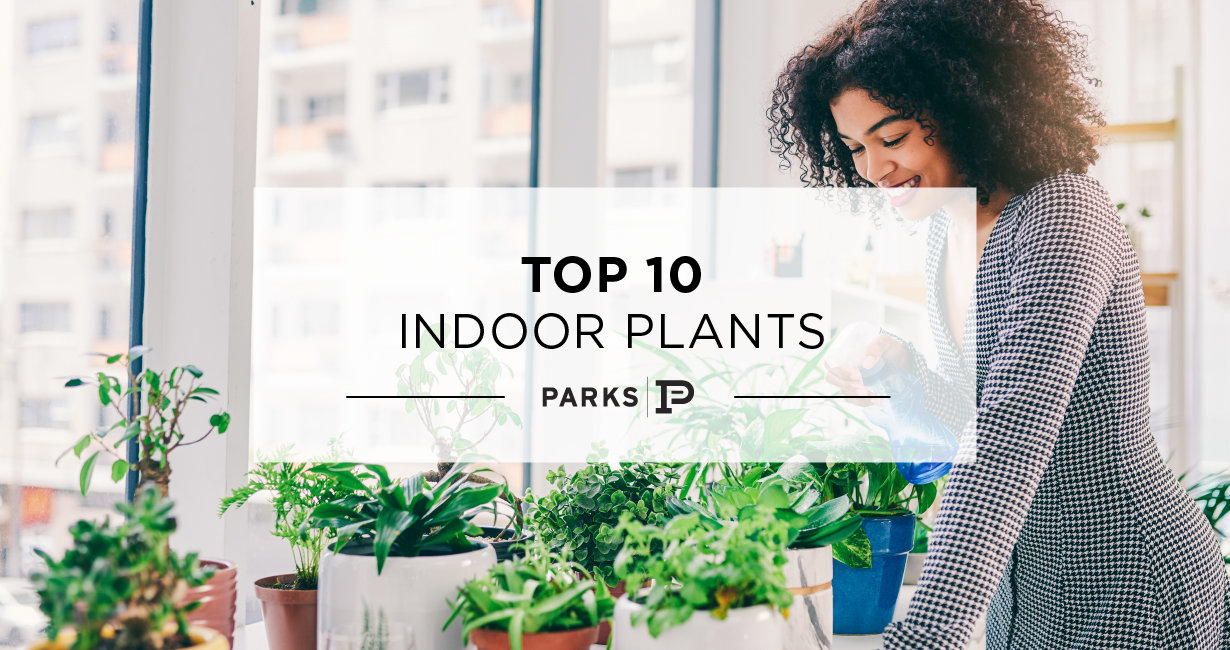
There’s something about bringing the outdoors in that really finishes off a space. Between the simple aesthetic upgrade (which also happens to be SO in right now), and the health benefits - adding some indoor plants to your place is always a great idea. While there are always the people that “can’t keep a plant alive for more than a day”, we’re here to tell you that with the right indoor plants chosen for this very purpose - you absolutely will be able to have a little thriving indoor oasis with minimal effort. Here are our top ten suggestions for indoor plants.
Snake Plant
Snake Plants gets its name from the rigid leaves that grow straight up with a little meandering around in different directions. Known for being able to survive droughts (great news for those that forget to water!), and even though it prefers bright light, can handle low light. You can honestly get away with watering it once a month and you’ll be amazed at how resilient they are. As a bonus, snake plants help filter out at least four major chemicals found in homes.
ZZ Plant
The ZZ Plant is another incredibly low maintenance plant. They can survive droughts because of their water storage in rhizomes (thick almost potato looking bases of the stalks) - which means we’re talking like once a month watering. ZZs can handle low light environments, as well as times of low humidity. Many cultures believe ZZ plans are a symbol of friendship and prosperity - making it a perfect housewarming gift.
Rubber Tree
Rubber Trees are cute and look like a tiny jungle tree. They do better with under watering than overwatering and need bright light (ideal is near a window with a sheer curtain for diffused bright light). They can get pretty tall over a few years, but can also be restricted to a small size if kept in a small pot. Don’t forget to dust the leaves!
Aloe Plant
Aloe plants are low maintenance AND healing. A double win. These plants give in so many ways and need to receive so little. All they ask for is bright light, and other than that they like to get extremely dry before another watering - so no need to stress about keeping it hydrated! Aloe leaves can be cut off and used for cuts and burns and so many other uses. Aloe is also known to help remove formaldehyde from the air.
Spider Plant
Spider plants are typically big and give a jungle vibe. They like bright, indirect light (think, IN a super sunny room, but not right on the window sill). Spider plants make baby spider plants easily and are easy to propagate (more spider plants!). They are strong in the air purifying department helping to remove both formaldehyde and xylene.
Philodendron
Philodendrons are large and leafy (more bang for the decorative buck!), and like to be dry - no more than one water per week (when the full top inch of soil feels dry). They like to be in bright places with no direct sun and are known for their quick growth.
Bonus: Unlike most plants, philodendrons don’t get stressed out when moving between indoor and outdoor settings!
Pothos
Known to some as the “cubicle plant” - a pothos is one of the ultimate plants for self-proclaimed “black thumbs” out there. With low light requirements, and tolerant of dry air (sound like a cubicle, yet?), the Pothos can thrive without much. While most start out small, they can grow to over 10 feet long with trailing vines. Better yet? By buying ONE pothos, you can essentially get endless pothos with how easy they are to grow more from one. They, like many of the other plants on this list, also filter out many air toxins.
Corn Plant
Called a “corn” plant because of it’s thick stem with thin, corn-like leaves coming out the top, this is another plant that can really make a statement depending on how old of one you get. While they grow slow, they typically reach 4 to 6 feet and can grow upwards of 10 feet tall. Corn plants do best with bright, indirect light (be careful not to scorch the leaves!), away from any drafty windows. Corn plants like the soil to dry out completely between watering, with less watering in the fall and winter when not in the growing season.
Jade
Jades have historically been used as housewarming gifts known to bring “good luck” to the owners! (Nothing says you can’t gift yourself one!) Jades like good light, so right in front of a window works well. Don’t forget to water when the soil feels dry to the touch (they may seem like they “don’t” need water because they are a succulent, but they do!), and prefer to keep their soil moist in the warmer, “growing” months, and only once a month during the fall and winter.
Fiddle Leaf Fig
Last but not least is the fiddle leaf fig, the current holy grail of the indoor plant world, but not as easy to take care of like the rest. Fiddle leaf figs have extremely large teardrop-shaped leaves that are the focal point of the plant (and let’s be honest, whatever room the plant is in!). Fiddle leaf figs like warm and moist conditions which is what makes it hard to grow indoors, but with practice and detailed care tips, it can most certainly be done. The biggest thing to keep track of is the water intake because fiddle leaf figs can both easily dry out and rot from overwatering.
Posted by Parks Compass on
Leave A Comment